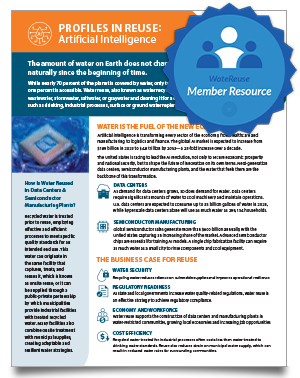Water Reuse for Artificial Intelligence
Water is the Fuel of the New Economy
Artificial intelligence is transforming every sector of the economy, from healthcare and manufacturing to logistics and finance. The global AI market is expected to increase from $189 billion in 2023 to $4.8 trillion by 2033—a 25-fold increase over a decade.
The United States is racing to lead the AI revolution, not only to secure economic prosperity and national security, but to shape the future of innovation on its own terms. Next-generation data centers, semiconductor manufacturing plants, and the water that fuels them are the backbone of this transformation.

Data Centers
As demand for data centers grows, so does demand for water. Data centers require significant amounts of water to cool machinery and maintain operations. U.S. data centers are expected to consume up to 33 billion gallons of water in 2028, while hyperscale data centers alone will use as much water as 299,154 households.

Semiconductor Manufacturing
Global semiconductor sales generate more than $600 billion annually, with the United States capturing an increasing share of the market. Advanced semiconductor chips are essential for training AI models. A single chip fabrication facility can require as much water as a small city to rinse components and cool equipment.
The Business Case for Reuse

Water Security
Recycling water reduces reliance on vulnerable supplies and improves operational resilience.

Regulatory Readiness
As state and local governments increase water quality-related regulations, water reuse is an effective strategy to achieve regulatory compliance.

Economy and Workforce
Water reuse supports the construction of data centers and manufacturing plants in water-restricted communities, growing local economies and increasing job opportunities.

Cost Efficiency
Recycled water treated for industrial processes often costs less than water treated to drinking water standards. Reuse also reduces strain on municipal water supply, which can result in reduced water rates for surrounding communities.
How Is Water Reused in Data Centers & Semiconductor Manufacturing Plants?
Recycled water is treated prior to reuse, employing effective and efficient processes to meet specific quality standards for an intended end use. This water can originate in the same facility that captures, treats, and reuses it, which is known as onsite reuse; or it can be supplied through a public-private partnership by which municipalities provide industrial facilities with treated recycled water. Many facilities also combine onsite treatment with municipal supplies, creating adaptable and resilient water strategies.
Examples of Water Reuse for AI
Water is an essential component for business. While new technologies and a better understanding of the benefits are increasing interest in industrial reuse, many data centers and microchip fabrication plants have already integrated recycled water into their daily operations.
Sustaining 9,000 Jobs | Chandler, AZ
In the late 90s, Intel Corporation and the City of Chandler, AZ, constructed the Ocotillo Brine Reduction Facility (OBRF). Intel’s investment in reuse systems has allowed it to scale up its operations in the desert Southwest, where water scarcity is a significant barrier to development, supporting about 9,000 jobs across Intel’s Ocotillo and Chandler campuses. Since becoming operational, the recycling plant has saved more than 5 billion gallons of water. Intel treats city water to the ultra-pure standard needed for microchip fabrication, rejecting some water that does not meet the standard of purity, or brine, in the process. The OBRF purifies brine using several mechanisms, including reverse osmosis, and returns 96% of it to the facility for manufacturing use.
Protecting Critical Equipment | Quincy, WA
Microsoft partnered with the City of Quincy to develop the Quincy Water Reuse Utility, a recycling facility designed to treat industrial cooling water. The system removes minerals from the water, extending the life of critical heat transfer equipment and improving operational efficiency. By enhancing the water reliability and resilience of the region, the facility also supports the local industrial community, including 673 full-time data center employees and contractors in Washington State. The use of recycled water not only provides drought resilience but also enables continued economic growth in the region.
Housing Data for 3,400 Companies | Loudoun County, VA
As the world’s largest concentration of data centers, Loudoun County’s Data Center Alley houses more than 3,400 technology companies, many of which employ massive servers that require cooling. Loudoun Water’s 20 miles of recycled water pipeline served these facilities with 736 million gallons of water in 2024. Loudoun Water’s recycled water fee is less than half the cost of drinking water per gallon, allowing companies to save money while reducing their impact on local water supplies.
$1.5 Billion in GDP | Douglas County, GA
Google’s Data Center in Douglas County, GA, diverts 30% of wastewater from the local municipal treatment plant for recycling, piping it into the data center for cooling. Increasing cycles of drought and high demand made the recycling facility essential for operating in hot summer months, allowing the data center to support 11,070 jobs and contribute nearly $1.5 billion to Georgia’s GDP annually from 2021-2023. In 2023, the data center withdrew 345.6 million gallons, over 90% of which was recycled water. Google’s investment in recycled water provides the foundation for its economic contributions in Georgia, supporting job growth and protecting local water supply.
Supporting Water Positive Commitments | Santa Clara, CA
The City of Santa Clara, California, manages a 33-mile recycled water pipeline network supplied by South Bay Water Recycling which delivers 2.3 million gallons per day of recycled water to 350 customers. Among the system’s 41 industrial users, Amazon Web Services operates three data centers which utilize recycled water from the pipeline for cooling. Amazon’s use of recycled water in Santa Clara supports AWS’s Water+ commitment to return more water to communities than used in direct operations by 2030.

